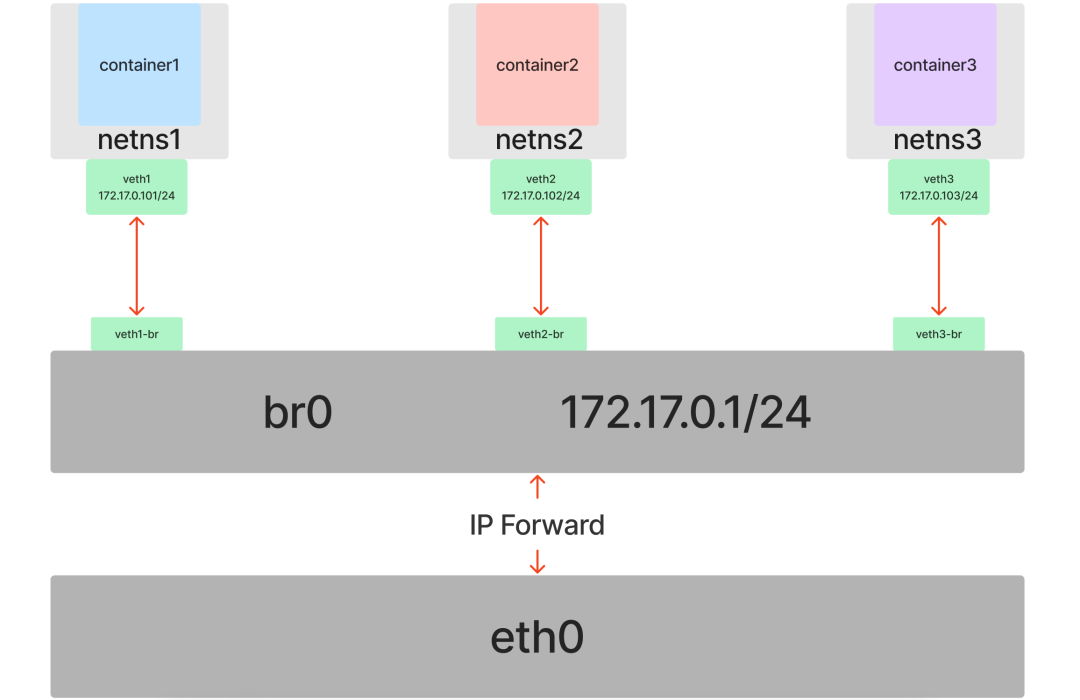Kubernetes
容器的本质就是一个特殊的进程,特殊在为其创建了 NameSpace 隔离运行环境,并用 Cgroups 为其控制资源开销。
借助这两个底层技术,可以成功实现应用容器化,但如何让多个容器在网络环境不互相干扰的情况下还能互相通信,让容器可以访问外部网络,让外部网络可以访问特定容器等等的这些容器的网络问题还得再利用一些 Linux 网络虚拟化技术。
容器网络隔离:NameSpace
让多个容器的网络环境不会互相干扰,可以延续之前 NameSpace 的知识点。 在前面介绍的 8 种 NameSpace 中,有一个 Network NameSpace ,可以借助这个来给容器配置独立的网络视图。 先看宿主机所处的 Default Network NameSpace :以 net:[4026531956] 为例,net 代表了 NameSpace 的类型,4026531956 则是 NameSpace 的 inode number。 经过之前的文章介绍,已经深知容器的本质就是进程,本文也不再浪费笔墨,接下来的操作将直接透过上层直达本质,借助 Linux 底层提供的能力来探索和还原容器网络的实现。(后续本文创建出的进程请直接理解为容器) 首先通过 ip netns 工具创建两个网络命名空间 netns1 和 netns2 :
[root@host ~]# readlink /proc/$$/ns/netnet:[4026531956][root@host ~]#
在这两个网络命名空间之上分别创建两个 bash
[root@host ~]# ip netns add netns1[root@host ~]# ip netns add netns2[root@host ~]# ip netns listnetns2netns1[root@host ~]#
同样的,container2 :
[root@host ~]# ip netns exec netns1 /bin/bash --rcfile <(echo "PS1=\"container1> \"")container1> readlink /proc/$$/ns/netnet:[4026532165]container1> ip link # 查看网络设备列表1: lo: <LOOPBACK> mtu 65536 qdisc noop state DOWN mode DEFAULT group default qlen 1000link/loopback 00:00:00:00:00:00 brd 00:00:00:00:00:00container1> route -n # 查看路由表Kernel IP routing tableDestination Gateway Genmask Flags Metric Ref Use Ifacecontainer1> iptables -L # 查看 iptables 规则Chain INPUT (policy ACCEPT)target prot opt source destinationChain FORWARD (policy ACCEPT)target prot opt source destinationChain OUTPUT (policy ACCEPT)target prot opt source destinationcontainer1>
可以看出,由于 Network NameSpace 隔离的作用,不同的容器( container1 和 container2 )拥有自己独立的网络协议栈,包括网络设备、路由表、ARP 表、iptables 规则、socket 等,所有的容器都会以为自己运行在独立的网络环境中。
[root@host ~]# ip netns exec netns2 /bin/bash --rcfile <(echo "PS1=\"container2> \"")container2> readlink /proc/$$/ns/netnet:[4026532219]container2> ip link # 查看网络设备列表1: lo: <LOOPBACK> mtu 65536 qdisc noop state DOWN mode DEFAULT group default qlen 1000link/loopback 00:00:00:00:00:00 brd 00:00:00:00:00:00container2> route -n # 查看路由表Kernel IP routing tableDestination Gateway Genmask Flags Metric Ref Use Ifacecontainer2> iptables -L # 查看 iptables 规则Chain INPUT (policy ACCEPT)target prot opt source destinationChain FORWARD (policy ACCEPT)target prot opt source destinationChain OUTPUT (policy ACCEPT)target prot opt source destinationcontainer2>
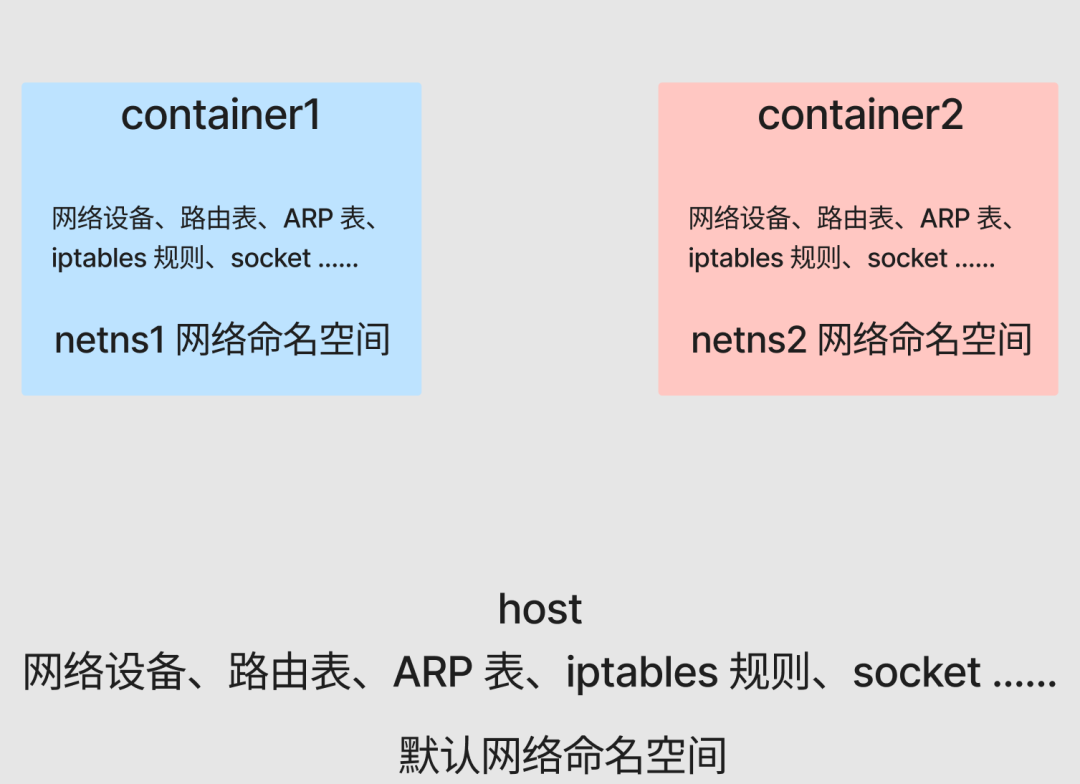
container1 :
package mainimport ("fmt""net/http""os")func main() {name := os.Args[1]http.HandleFunc("/", func(w http.ResponseWriter, r *http.Request) {fmt.Println("req")w.Write([]byte(name + "\n"))})fmt.Println(name, "listen :8080")panic(http.ListenAndServe(":8080", nil))}
container2 :
container1> go run main.go container1 > container1.log &[1] 2866container1> tail container1.logcontainer1 listen :8080container1>
当前在同一主机下,即使 container1 和 container2 都监听着 8080 端口,也并不会发生端口冲突。 测试一下刚才所启动的服务的可用性,以 container1 为例:
container2> go run main.go container2 > container2.log &[1] 2955container2> tail container2.logcontainer2 listen :8080container2>
此时访问不通是因为根本还没有启用任何网络设备,包括基本的 lo 回路设备。直接将其启用即可:
container1> curl localhost:8080curl: (7) Failed to connect to ::1: Network is unreachablecontainer1>
container2 同理。
container1> ifconfigcontainer1> ifup locontainer1> ifconfiglo: flags=73<UP,LOOPBACK,RUNNING> mtu 65536inet 127.0.0.1 netmask 255.0.0.0inet6 ::1 prefixlen 128 scopeid 0x10<host>loop txqueuelen 1000 (Local Loopback)RX packets 0 bytes 0 (0.0 B)RX errors 0 dropped 0 overruns 0 frame 0TX packets 0 bytes 0 (0.0 B)TX errors 0 dropped 0 overruns 0 carrier 0 collisions 0container1> curl localhost:8080container1container1>
容器点对点通信:Veth
当前两个容器处于不同的 Network NameSpace 中,它们的网络环境是互相隔离的,你不认识我,我也不认识你,它们之间自然也无法进行网络通信。 在进入解决办法之前,回顾下,在现实世界中,如果两台计算机需要互相进行网络通信。

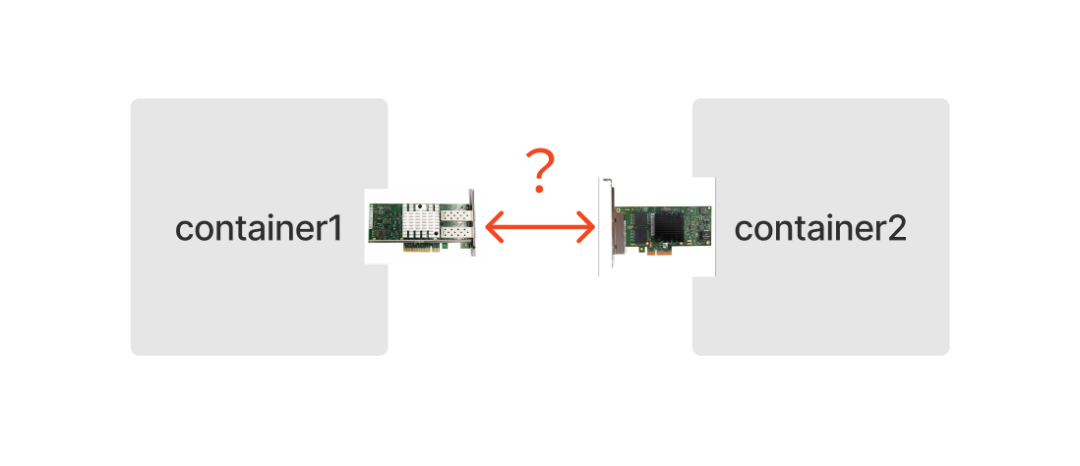
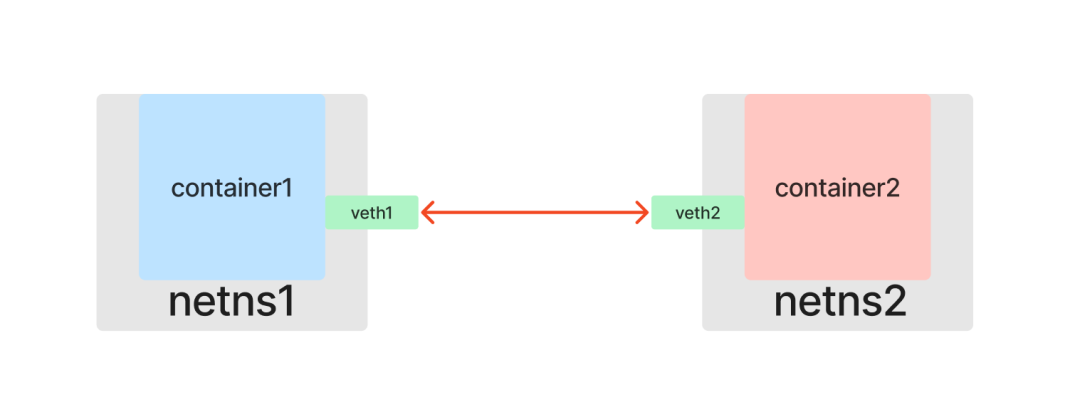
创建一个 veth pair (包含 veth1 和 veth2 两个虚拟网络设备):
[root@host ~]# ip link1: lo: <LOOPBACK,UP,LOWER_UP> mtu 65536 qdisc noqueue state UNKNOWN mode DEFAULT group default qlen 1000link/loopback 00:00:00:00:00:00 brd 00:00:00:00:00:002: eth0: <BROADCAST,MULTICAST,UP,LOWER_UP> mtu 1500 qdisc mq state UP mode DEFAULT group default qlen 1000link/ether 52:54:00:26:eb:d4 brd ff:ff:ff:ff:ff:ff[root@host ~]#
直接将一端的虚拟网卡 veth1 放入 netns1 命名空间,另一端的 veth2 放入 netns2 命名空间,这样就相当于使用网线将两个命名空间连接起来了:
[root@host ~]# ip link add veth1 type veth peer name veth2[root@host ~]# ip link1: lo: <LOOPBACK,UP,LOWER_UP> mtu 65536 qdisc noqueue state UNKNOWN mode DEFAULT group default qlen 1000link/loopback 00:00:00:00:00:00 brd 00:00:00:00:00:002: eth0: <BROADCAST,MULTICAST,UP,LOWER_UP> mtu 1500 qdisc mq state UP mode DEFAULT group default qlen 1000link/ether 52:54:00:26:eb:d4 brd ff:ff:ff:ff:ff:ff3: veth2@veth1: <BROADCAST,MULTICAST,M-DOWN> mtu 1500 qdisc noop state DOWN mode DEFAULT group default qlen 1000link/ether 6a:01:c8:fa:9e:6e brd ff:ff:ff:ff:ff:ff4: veth1@veth2: <BROADCAST,MULTICAST,M-DOWN> mtu 1500 qdisc noop state DOWN mode DEFAULT group default qlen 1000link/ether 42:7e:de:c6:89:ff brd ff:ff:ff:ff:ff:ff[root@host ~]#
连接起来后就可以在 container1 和 container2 容器中查看到各自对应的网络设备:
[root@host ~]# ip link set veth1 netns netns1[root@host ~]# ip link set veth2 netns netns2[root@host ~]#
container1> ip link1: lo: <LOOPBACK,UP,LOWER_UP> mtu 65536 qdisc noqueue state UNKNOWN mode DEFAULT group default qlen 1000link/loopback 00:00:00:00:00:00 brd 00:00:00:00:00:004: veth1@if3: <BROADCAST,MULTICAST> mtu 1500 qdisc noop state DOWN mode DEFAULT group default qlen 1000link/ether 42:7e:de:c6:89:ff brd ff:ff:ff:ff:ff:ff link-netnsid 1container1>
分别为这两个网卡设置 IP 地址,使其位于同一个子网 172.17.0.0/24 中,然后启用网卡:
container2> ip link1: lo: <LOOPBACK,UP,LOWER_UP> mtu 65536 qdisc noqueue state UNKNOWN mode DEFAULT group default qlen 1000link/loopback 00:00:00:00:00:00 brd 00:00:00:00:00:003: veth2@if4: <BROADCAST,MULTICAST> mtu 1500 qdisc noop state DOWN mode DEFAULT group default qlen 1000link/ether 6a:01:c8:fa:9e:6e brd ff:ff:ff:ff:ff:ff link-netnsid 0container2>
container1> ip addr add 172.17.0.101/24 dev veth1container1> ip link set dev veth1 upcontainer1> ifconfiglo: flags=73<UP,LOOPBACK,RUNNING> mtu 65536inet 127.0.0.1 netmask 255.0.0.0inet6 ::1 prefixlen 128 scopeid 0x10<host>loop txqueuelen 1000 (Local Loopback)RX packets 10 bytes 942 (942.0 B)RX errors 0 dropped 0 overruns 0 frame 0TX packets 10 bytes 942 (942.0 B)TX errors 0 dropped 0 overruns 0 carrier 0 collisions 0veth1: flags=4099<UP,BROADCAST,MULTICAST> mtu 1500inet 172.17.0.101 netmask 255.255.255.0 broadcast 0.0.0.0ether 42:7e:de:c6:89:ff txqueuelen 1000 (Ethernet)RX packets 0 bytes 0 (0.0 B)RX errors 0 dropped 0 overruns 0 frame 0TX packets 0 bytes 0 (0.0 B)TX errors 0 dropped 0 overruns 0 carrier 0 collisions 0container1>
测试 container1 和 container2 容器互相访问对方的服务:
container2> ip addr add 172.17.0.102/24 dev veth2container2> ip link set dev veth2 upcontainer2> ifconfiglo: flags=73<UP,LOOPBACK,RUNNING> mtu 65536inet 127.0.0.1 netmask 255.0.0.0inet6 ::1 prefixlen 128 scopeid 0x10<host>loop txqueuelen 1000 (Local Loopback)RX packets 10 bytes 942 (942.0 B)RX errors 0 dropped 0 overruns 0 frame 0TX packets 10 bytes 942 (942.0 B)TX errors 0 dropped 0 overruns 0 carrier 0 collisions 0veth2: flags=4163<UP,BROADCAST,RUNNING,MULTICAST> mtu 1500inet 172.17.0.102 netmask 255.255.255.0 broadcast 0.0.0.0inet6 fe80::6801:c8ff:fefa:9e6e prefixlen 64 scopeid 0x20<link>ether 6a:01:c8:fa:9e:6e txqueuelen 1000 (Ethernet)RX packets 6 bytes 516 (516.0 B)RX errors 0 dropped 0 overruns 0 frame 0TX packets 6 bytes 516 (516.0 B)TX errors 0 dropped 0 overruns 0 carrier 0 collisions 0container2>
container1> curl 172.17.0.102:8080container2container1>
到这里,只需依靠 Veth ,就得到了一个点对点的二层网络拓扑,容器点对点通信的问题也得以成功解决。
container2> curl 172.17.0.101:8080container1container2>
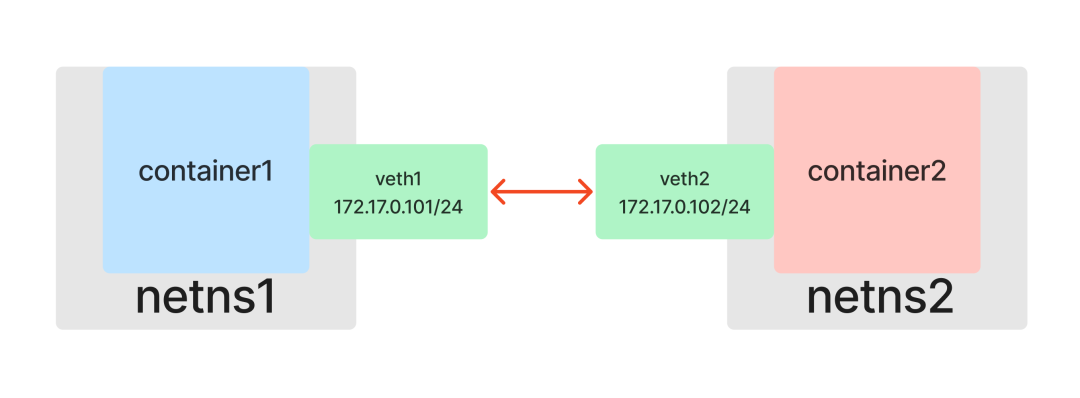
容器间互相通信:Bridge
在现实世界中,不可能只有两台计算机,当有第三台、第四台,乃至无数台计算机加入到网络环境中的时候,不可能有这么多网口可以彼此两两互相连接。为了解决这个问题,便发明了二层交换机(或网桥)。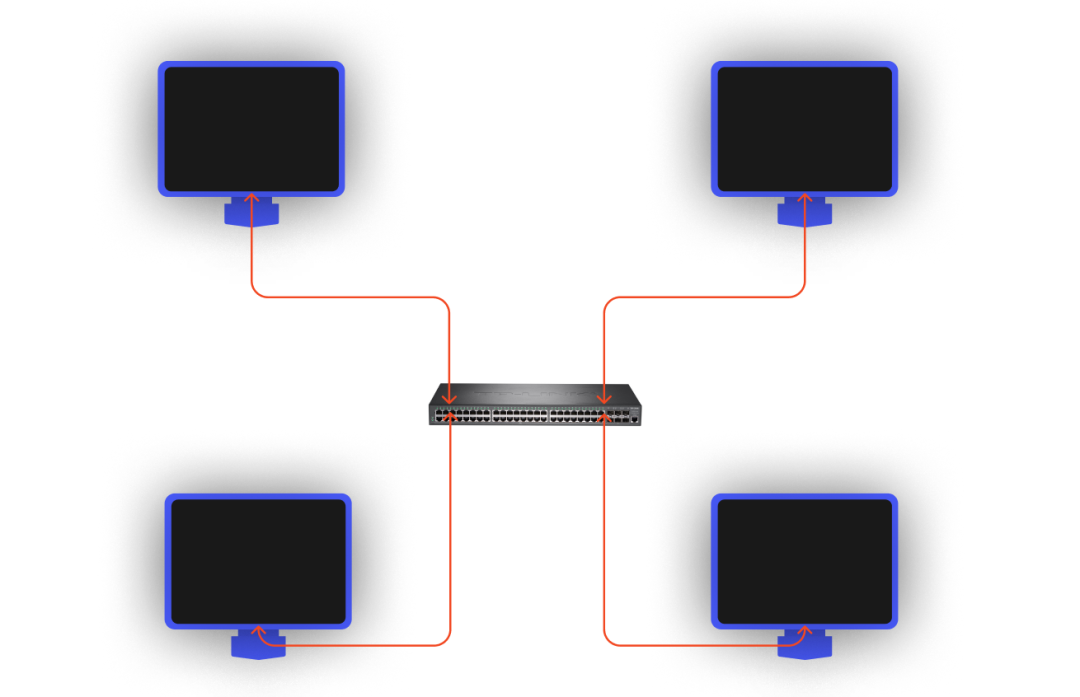
重复之前的操作,创建 container3 容器:
[root@host ~]# ip netns add netns3[root@host ~]# ip netns listnetns3netns2 (id: 1)netns1 (id: 0)[root@host ~]#
在为这三个容器互相通网之前,先把之前给 container1 和 container2 容器之间连接的“网线”(veth1 和 veth2 )拔了(只需在其中一个容器中操作):
[root@host ~]# ip netns exec netns3 /bin/bash --rcfile <(echo "PS1=\"container3> \"")container3> readlink /proc/$$/ns/netnet:[4026532277]container3> go run main.go container3 > container3.log &[1] 4270container3> tail container3.logcontainer3 listen :8080container3> ifup locontainer3> ifconfiglo: flags=73<UP,LOOPBACK,RUNNING> mtu 65536inet 127.0.0.1 netmask 255.0.0.0inet6 ::1 prefixlen 128 scopeid 0x10<host>loop txqueuelen 1000 (Local Loopback)RX packets 0 bytes 0 (0.0 B)RX errors 0 dropped 0 overruns 0 frame 0TX packets 0 bytes 0 (0.0 B)TX errors 0 dropped 0 overruns 0 carrier 0 collisions 0container3> curl localhost:8080container3container3>
现在三个容器之间就谁也不认识谁了。 回归实践,创建一个 Bridge ,并将其启用:
container1> ip link delete veth1container1> ip link1: lo: <LOOPBACK,UP,LOWER_UP> mtu 65536 qdisc noqueue state UNKNOWN mode DEFAULT group default qlen 1000link/loopback 00:00:00:00:00:00 brd 00:00:00:00:00:00container1>
准备三条“网线”(三对 veth):
[root@host ~]# ip link add br0 type bridge[root@host ~]# ip link1: lo: <LOOPBACK,UP,LOWER_UP> mtu 65536 qdisc noqueue state UNKNOWN mode DEFAULT group default qlen 1000link/loopback 00:00:00:00:00:00 brd 00:00:00:00:00:002: eth0: <BROADCAST,MULTICAST,UP,LOWER_UP> mtu 1500 qdisc mq state UP mode DEFAULT group default qlen 1000link/ether 52:54:00:26:eb:d4 brd ff:ff:ff:ff:ff:ff5: br0: <BROADCAST,MULTICAST> mtu 1500 qdisc noop state DOWN mode DEFAULT group default qlen 1000link/ether 9e:ac:12:15:98:64 brd ff:ff:ff:ff:ff:ff[root@host ~]# ip link set dev br0 up[root@host ~]# ifconfigbr0: flags=4163<UP,BROADCAST,RUNNING,MULTICAST> mtu 1500inet6 fe80::9cac:12ff:fe15:9864 prefixlen 64 scopeid 0x20<link>ether 9e:ac:12:15:98:64 txqueuelen 1000 (Ethernet)RX packets 0 bytes 0 (0.0 B)RX errors 0 dropped 0 overruns 0 frame 0TX packets 6 bytes 516 (516.0 B)TX errors 0 dropped 0 overruns 0 carrier 0 collisions 0eth0: flags=4163<UP,BROADCAST,RUNNING,MULTICAST> mtu 1500inet 10.0.12.15 netmask 255.255.252.0 broadcast 10.0.15.255inet6 fe80::5054:ff:fe26:ebd4 prefixlen 64 scopeid 0x20<link>ether 52:54:00:26:eb:d4 txqueuelen 1000 (Ethernet)RX packets 114601 bytes 160971385 (153.5 MiB)RX errors 0 dropped 0 overruns 0 frame 0TX packets 18824 bytes 2035143 (1.9 MiB)TX errors 0 dropped 0 overruns 0 carrier 0 collisions 0lo: flags=73<UP,LOOPBACK,RUNNING> mtu 65536inet 127.0.0.1 netmask 255.0.0.0inet6 ::1 prefixlen 128 scopeid 0x10<host>loop txqueuelen 1000 (Local Loopback)RX packets 15 bytes 2000 (1.9 KiB)RX errors 0 dropped 0 overruns 0 frame 0TX packets 15 bytes 2000 (1.9 KiB)TX errors 0 dropped 0 overruns 0 carrier 0 collisions 0[root@host ~]#
将 veth1 插入 netns1 、veth1-br 插入 br0 、 veth2 插入 netns2 、veth2-br 插入 br0 、 veth3 插入 netns3 、veth3-br 插入 br0 (记得启用 veth*-br ):
[root@host ~]# ip link add veth1 type veth peer name veth1-br[root@host ~]# ip link add veth2 type veth peer name veth2-br[root@host ~]# ip link add veth3 type veth peer name veth3-br[root@host ~]#
分别在三个容器中,为各自的网卡设置 IP 地址,并使其位于同一个子网 172.17.0.0/24 中,设置完后同样需要进行启用操作:
[root@host ~]# ip link set dev veth1 netns netns1[root@host ~]# ip link set dev veth2 netns netns2[root@host ~]# ip link set dev veth3 netns netns3[root@host ~]# ip link set dev veth1-br master br0[root@host ~]# ip link set dev veth2-br master br0[root@host ~]# ip link set dev veth3-br master br0[root@host ~]# ip link set dev veth1-br up[root@host ~]# ip link set dev veth2-br up[root@host ~]# ip link set dev veth3-br up[root@host ~]#
container1> ip addr add 172.17.0.101/24 dev veth1container1> ip link set dev veth1 upcontainer1>
container2> ip addr add 172.17.0.102/24 dev veth2container2> ip link set dev veth2 upcontainer2>
测试 container1 、 container2 、container3 容器互相访问对方的服务:
container3> ip addr add 172.17.0.103/24 dev veth3container3> ip link set dev veth3 upcontainer3>
container1> curl 172.17.0.102:8080container2container1> curl 172.17.0.103:8080container3container1>
container2> curl 172.17.0.101:8080container1container2> curl 172.17.0.103:8080container3container2>
至此,在 Veth 的基础上,引入 Bridge 功能,将多个 Namespace 连接到了同一个二层网络中,容器间互相通信的问题得以成功解决。
container3> curl 172.17.0.101:8080container1container3> curl 172.17.0.102:8080container2container3>
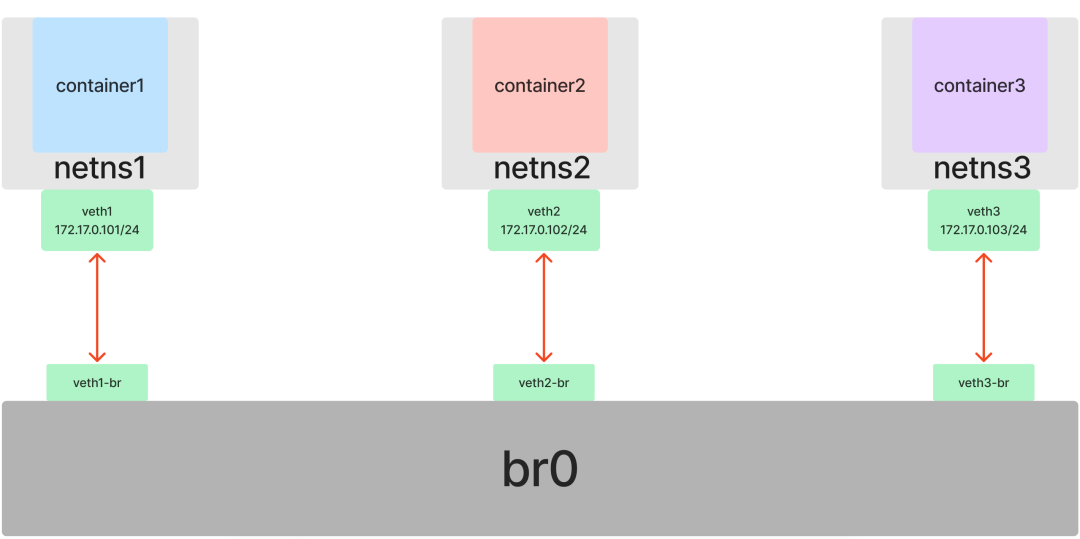
容器与外部网络通信:route 和 iptables
目前为止,实验都是处于同一子网中。但实际的应用场景,更多的是需要容器可以与外部进行互通。 在现实世界中,二层交换机只能解决同一子网内的数据流向,对于不同子网,就需要使用三层路由器(或网关)来转发。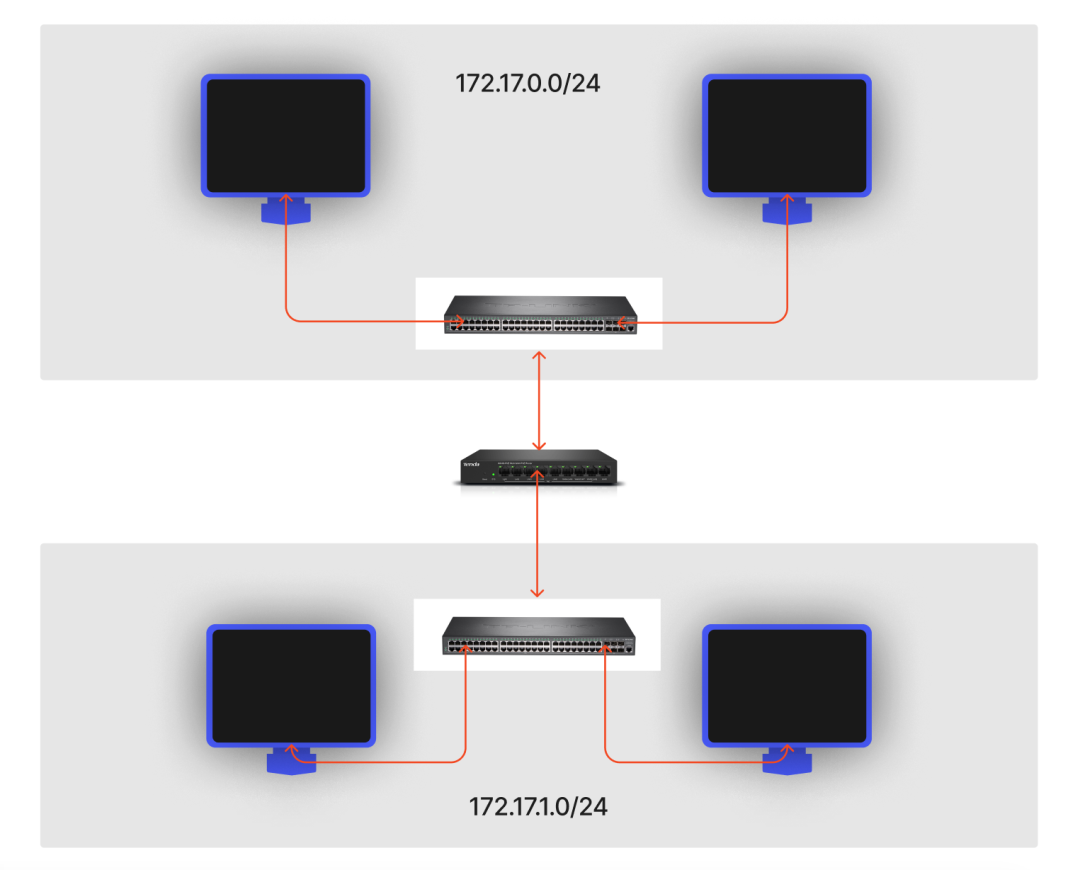
如果要查看指定的路由表中的规则可以使用
[root@host ~]# cat /etc/iproute2/rt_tables## reserved values#255 local254 main253 default0 unspec## local##1 inr.ruhep[root@host ~]#
<font style="color:rgb(60, 112, 198);">ip route list table 表名</font> :
平时使用的
[root@host ~]# ip route list table localbroadcast 10.0.12.0 dev eth0 proto kernel scope link src 10.0.12.15local 10.0.12.15 dev eth0 proto kernel scope host src 10.0.12.15broadcast 10.0.15.255 dev eth0 proto kernel scope link src 10.0.12.15broadcast 127.0.0.0 dev lo proto kernel scope link src 127.0.0.1local 127.0.0.0/8 dev lo proto kernel scope host src 127.0.0.1local 127.0.0.1 dev lo proto kernel scope host src 127.0.0.1broadcast 127.255.255.255 dev lo proto kernel scope link src 127.0.0.1[root@host ~]# ip route list table maindefault via 10.0.12.1 dev eth010.0.12.0/22 dev eth0 proto kernel scope link src 10.0.12.15169.254.0.0/16 dev eth0 scope link metric 1002[root@host ~]# route -nKernel IP routing tableDestination Gateway Genmask Flags Metric Ref Use Iface0.0.0.0 10.0.12.1 0.0.0.0 UG 0 0 0 eth010.0.12.0 0.0.0.0 255.255.252.0 U 0 0 0 eth0169.254.0.0 0.0.0.0 255.255.0.0 U 1002 0 0 eth0[root@host ~]#
<font style="color:rgb(60, 112, 198);">route -n</font> 命令实际就是在查看 main 路由表。
容器和宿主机互通
现在有 container1 、 container2 和 container3 三个容器,其 IP 分别为:172.17.0.101 、172.17.0.102 和 172.17.0.103 ,它们都处于同一子网中。 查看宿主机的 IP ,这里是 10.0.12.15 :查看容器(以 container1 为例)的路由规则:
[root@host ~]# ifconfig...eth0: flags=4163<UP,BROADCAST,RUNNING,MULTICAST> mtu 1500inet 10.0.12.15 netmask 255.255.252.0 broadcast 10.0.15.255inet6 fe80::5054:ff:fe26:ebd4 prefixlen 64 scopeid 0x20<link>ether 52:54:00:26:eb:d4 txqueuelen 1000 (Ethernet)RX packets 119923 bytes 161411733 (153.9 MiB)RX errors 0 dropped 0 overruns 0 frame 0TX packets 24106 bytes 2884317 (2.7 MiB)TX errors 0 dropped 0 overruns 0 carrier 0 collisions 0...[root@host ~]#
可以发现,当前容器的路由表中只有一条规则:当访问 172.17.0.0/24 子网内的 IP 时,例如 172.17.0.102 ,数据包直接转发到 veth1 设备。 根据 Veth 的性质,对应 veth1 的另一端 veth1-br 设备就会接收到数据包,又由于 veth1-br 设备是连接在 br0 二层交换机上的,所以 veth2-br 设备也会接收到该数据包,最后就到达了对应的 veth2 目标设备。 现在的目的就是要让容器访问除了 172.17.0.0/24 子网内的 IP 的其它 IP 时(比如宿主机 IP 10.0.12.15),也可以把数据包转发出去,也就是需要给容器增加路由规则。 回想之前的 Bridge ,从网络角度上看,是把它当作一个二层交换机,所以不需要为它设置 IP 地址,但现在从宿主机的角度上看,br0 同时也是 Default Network Namespace 里面的一张网卡,可以直接为这张网卡设置 IP 后,来充当三层路由器(网关),参与主机的路由转发。 在宿主机上给 br0 设备设置 IP 地址为 172.17.0.1 (同样位于子网 172.17.0.0/24 内):
container1> route -nKernel IP routing tableDestination Gateway Genmask Flags Metric Ref Use Iface172.17.0.0 0.0.0.0 255.255.255.0 U 0 0 0 veth1container1>
此时,宿主机会自动增加一条 Destination 为 172.17.0.0 的路由规则:
[root@host ~]# ip addr add local 172.17.0.1/24 dev br0[root@host ~]# ifconfigbr0: flags=4163<UP,BROADCAST,RUNNING,MULTICAST> mtu 1500inet 172.17.0.1 netmask 255.255.255.0 broadcast 0.0.0.0inet6 fe80::9cac:12ff:fe15:9864 prefixlen 64 scopeid 0x20<link>ether 16:bd:7d:ca:53:bf txqueuelen 1000 (Ethernet)RX packets 27 bytes 1716 (1.6 KiB)RX errors 0 dropped 0 overruns 0 frame 0TX packets 8 bytes 656 (656.0 B)TX errors 0 dropped 0 overruns 0 carrier 0 collisions 0......
按照这条路由规则(访问目标主机为 172.17.0.0/24 的数据包会转发到 br0 设备),现在的宿主机就可以直接访问容器了:
[root@host ~]# route -nKernel IP routing tableDestination Gateway Genmask Flags Metric Ref Use Iface0.0.0.0 10.0.12.1 0.0.0.0 UG 0 0 0 eth010.0.12.0 0.0.0.0 255.255.252.0 U 0 0 0 eth0169.254.0.0 0.0.0.0 255.255.0.0 U 1002 0 0 eth0172.17.0.0 0.0.0.0 255.255.255.0 U 0 0 0 br0[root@host ~]#
现在宿主机可以访问容器了,回到容器访问宿主机的问题上,给容器增加路由转发规则,使默认所有路由(0.0.0.0 ,除了 172.17.0.0/24 子网内的 IP )都需要透过作用于三层的 br0 网关(172.17.0.1)来转递封包:
[root@host ~]# ping 172.17.0.101PING 172.17.0.101 (172.17.0.101) 56(84) bytes of data.64 bytes from 172.17.0.101: icmp_seq=1 ttl=64 time=0.025 ms64 bytes from 172.17.0.101: icmp_seq=2 ttl=64 time=0.037 ms64 bytes from 172.17.0.101: icmp_seq=3 ttl=64 time=0.031 ms^C--- 172.17.0.101 ping statistics ---3 packets transmitted, 3 received, 0% packet loss, time 1999msrtt min/avg/max/mdev = 0.025/0.031/0.037/0.005 ms[root@host ~]# curl 172.17.0.101:8080container1[root@host ~]#
这样一来,当容器访问宿主机 IP 时,数据包就会直接转发到 Default Network Namespace 的 br0 网卡上,宿主机发现收到的 IP 数据包是属于自己的,就会对其进行处理。 也就是说现在容器也可以访问宿主机了:
container1> ip route add default via 172.17.0.1container1> route -nKernel IP routing tableDestination Gateway Genmask Flags Metric Ref Use Iface0.0.0.0 172.17.0.1 0.0.0.0 UG 0 0 0 veth1172.17.0.0 0.0.0.0 255.255.255.0 U 0 0 0 veth1container1>
container1> ping 10.0.12.15PING 10.0.12.15 (10.0.12.15) 56(84) bytes of data.64 bytes from 10.0.12.15: icmp_seq=1 ttl=64 time=0.022 ms64 bytes from 10.0.12.15: icmp_seq=2 ttl=64 time=0.031 ms64 bytes from 10.0.12.15: icmp_seq=3 ttl=64 time=0.032 ms^C--- 10.0.12.15 ping statistics ---3 packets transmitted, 3 received, 0% packet loss, time 1999msrtt min/avg/max/mdev = 0.022/0.028/0.032/0.006 mscontainer1>
容器访问其它主机(外网)
上面给容器配置了路由规则,使其访问宿主机 IP 时,数据包就会转发到 Default Network Namespace 的 br0 网卡上,宿主机发现收到的 IP 数据包是属于自己的,就会对其进行处理。 但在 Linux 中,如果发现收到的 IP 数据包并不是属于自己的,是会将其直接丢弃的。这里准备了一个和宿主机(10.0.12.15)同一子网的另一台 IP 地址为 10.0.12.11 的主机 host2 来测试:在 container1 内 ping host2 ,以及访问外网,和预期一致,无法访问:
[root@host2 ~]# ifconfigeth0: flags=4163<UP,BROADCAST,RUNNING,MULTICAST> mtu 1500inet 10.0.12.11 netmask 255.255.252.0 broadcast 10.0.15.255inet6 fe80::5054:ff:fe78:a238 prefixlen 64 scopeid 0x20<link>ether 52:54:00:78:a2:38 txqueuelen 1000 (Ethernet)RX packets 6103 bytes 2710292 (2.5 MiB)RX errors 0 dropped 0 overruns 0 frame 0TX packets 4662 bytes 640093 (625.0 KiB)TX errors 0 dropped 0 overruns 0 carrier 0 collisions 0lo: flags=73<UP,LOOPBACK,RUNNING> mtu 65536inet 127.0.0.1 netmask 255.0.0.0inet6 ::1 prefixlen 128 scopeid 0x10<host>loop txqueuelen 1000 (Local Loopback)RX packets 10 bytes 1360 (1.3 KiB)RX errors 0 dropped 0 overruns 0 frame 0TX packets 10 bytes 1360 (1.3 KiB)TX errors 0 dropped 0 overruns 0 carrier 0 collisions 0[root@host2 ~]#
如果想要在容器中可以访问其他主机,或者外网,就不能让 Linux 丢弃不属于自己的数据包,而是继续转发出去。要做到这一点,只需要打开 Linux 的 IP Forward 功能:
container1> ping 10.0.12.11PING 10.0.12.11 (10.0.12.11) 56(84) bytes of data.^C--- 10.0.12.11 ping statistics ---16 packets transmitted, 0 received, 100% packet loss, time 14999mscontainer1> curl baidu.comcurl: (6) Could not resolve host: baidu.com; Unknown errorcontainer1>
但是,这里还是会有一个问题,当容器访问其他主机或者外网时(veth1->br0),Linux 也转发了出去(br0->eth0),但其他主机或者外网在响应了容器的请求时,它并不认识配置的 172.17.0.0/24 这个网段,还是无法成功处理请求。所以还需要使用 NAT( Network Address Translation )技术:把 IP 数据报文头中的 IP 地址和端口转换成另一个 IP 地址和端口。
[root@host ~]# cat /proc/sys/net/ipv4/ip_forward # 0 代表关闭,1 代表开启0[root@host ~]# vi /etc/sysctl.d/30-ipforward.confnet.ipv4.ip_forward=1net.ipv6.conf.default.forwarding=1net.ipv6.conf.all.forwarding=1[root@host ~]# sysctl -p /etc/sysctl.d/30-ipforward.confnet.ipv4.ip_forward = 1net.ipv6.conf.default.forwarding = 1net.ipv6.conf.all.forwarding = 1[root@host ~]# cat /proc/sys/net/ipv4/ip_forward # 0 代表关闭,1 代表开启1[root@host ~]#
NAT 技术也被用于 IPv4 地址枯竭问题
在这里需要修改的是源 IP 地址,所以是 SNAT (Source NAT),把 IP 转换成宿主机出口网卡的 IP 。 在 Linux 中,可以通过 iptables 中的 MASQUERADE 策略来实现这个 SNAT :这条规则的意思是将不是从网卡 br0 发出的且源地址为 172.17.0.0/24 的数据包(即容器中发出的数据包)做 SNAT 。 此时,容器就可以访问其它主机(外网)了:
[root@host ~]# iptables -t nat -A POSTROUTING -s 172.17.0.0/24 ! -o br0 -j MASQUERADE[root@host ~]# iptables -t nat -nLChain PREROUTING (policy ACCEPT)target prot opt source destinationChain INPUT (policy ACCEPT)target prot opt source destinationChain OUTPUT (policy ACCEPT)target prot opt source destinationChain POSTROUTING (policy ACCEPT)target prot opt source destinationMASQUERADE all -- 172.17.0.0/24 0.0.0.0/0[root@host ~]#
container1> ping 10.0.12.11PING 10.0.12.11 (10.0.12.11) 56(84) bytes of data.64 bytes from 10.0.12.11: icmp_seq=1 ttl=63 time=0.231 ms64 bytes from 10.0.12.11: icmp_seq=2 ttl=63 time=0.216 ms64 bytes from 10.0.12.11: icmp_seq=3 ttl=63 time=0.206 ms^C--- 10.0.12.11 ping statistics ---3 packets transmitted, 3 received, 0% packet loss, time 1999msrtt min/avg/max/mdev = 0.206/0.217/0.231/0.019 mscontainer1> curl baidu.com<html><meta http-equiv="refresh" content="0;url=http://www.baidu.com/"></html>container1>
外部访问容器(容器端口映射)
容器与外部网络通信,已经解决了容器和宿主机间的通信,容器访问其他主机(外网),还剩最后一个,外部来访问容器。 在 Docker 中,要让外部可以访问容器服务,会做一次容器端口映射,如:通过
[root@host ~]# docker run -p 8000:8080 xxx
<font style="color:rgb(60, 112, 198);">-p</font> 参数就可以将容器内的 8080 端口映射到宿主机的 8000 端口上,这样外部就可以通过访问宿主机 IP + 8000 端口访问到容器服务了。
这一技术实现其实同样是使用到了 NAT 技术,只不过和上面的 SNAT 不同的是,这里需要修改的是目的 IP 地址,即 DNAT (Destination NAT),把宿主机上 8000 端口的流量请求转发到容器中的地址 172.17.0.101:8080 中。
在 Linux 中,可以通过 iptables 中的 DNAT 策略来实现这个 DNAT :
这条规则的意思是将访问宿主机 8000 端口的请求转发到 172.17.0.101 的 8080 端口上,也就是说现在可以在 host2 主机(10.0.12.11)上通过访问 10.0.12.15:8000 来访问实际的 container1 服务了:
[root@host ~]# iptables -t nat -A PREROUTING ! -i br0 -p tcp -m tcp --dport 8000 -j DNAT --to-destination 172.17.0.101:8080[root@host ~]# iptables -t nat -nLChain PREROUTING (policy ACCEPT)target prot opt source destinationDNAT tcp -- 0.0.0.0/0 0.0.0.0/0 tcp dpt:8000 to:172.17.0.101:8080Chain INPUT (policy ACCEPT)target prot opt source destinationChain OUTPUT (policy ACCEPT)target prot opt source destinationChain POSTROUTING (policy ACCEPT)target prot opt source destinationMASQUERADE all -- 172.17.0.0/24 0.0.0.0/0[root@host ~]#
到这里,就已经实现了一个和 Docker 默认网络模式一样的拓扑关系:
[root@host2 ~]# curl 10.0.12.15:8000container1[root@host2 ~]#
